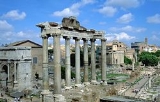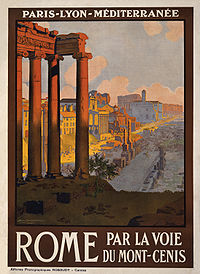
Temple of Saturn
Encyclopedia
The Temple of Saturn (Latin
: Templum Saturni or Aedes Saturnus) is a monument
to the agricultural deity
. The Temple of Saturn
stands at the foot of the Capitoline Hill
in the western end of the Forum Romanum in Rome
, Italy
.
standing, but the eight surviving column
s and partially intact pediment
(displaying the inscription Senatus Populusque Romanus incendio consumptum restituit, meaning "The Senate
and People of Rome
restored what fire had consumed") represent one of the iconic images of Rome's ancient architectural heritage
.
. Construction of the temple is thought to have begun in later years of the regal era
under Tarquinius Superbus, with its inauguration by the Consul
Titus Lartius taking place in the early years of the Republic
. The temple was completely reconstructed by Munatius Plancus in 42 BC
.
The present ruins represent the third incarnation of the Temple of Saturn, replacing the second incarnation destroyed by the fire of Carinus
in 283 AD
. The extant inscription on the frieze (Senatus Populusque Romanus incendio consumptum restituit) commemorates the restoration undertaken after the fire.

, was wooden and filled with oil. The legs were covered with linen bents, which were released only on December 17, the day of the Saturnalia
.
While dedicated to the god Saturn, the temple's chief use was as the seat of the treasury of the Roman Republic
(aerarium
), storing the Republic's reserves of gold
and silver
. Also the state archives, the insignia and the official scale for the weighing of metals were housed in the temple. Later, the aerarium was moved to another building, while the archives were transferred to the nearby Tabularium
. The temple's podium, in concrete covered with travertine
, was used for bill-posting.
Latin
Latin is an Italic language originally spoken in Latium and Ancient Rome. It, along with most European languages, is a descendant of the ancient Proto-Indo-European language. Although it is considered a dead language, a number of scholars and members of the Christian clergy speak it fluently, and...
: Templum Saturni or Aedes Saturnus) is a monument
Monument
A monument is a type of structure either explicitly created to commemorate a person or important event or which has become important to a social group as a part of their remembrance of historic times or cultural heritage, or simply as an example of historic architecture...
to the agricultural deity
Roman mythology
Roman mythology is the body of traditional stories pertaining to ancient Rome's legendary origins and religious system, as represented in the literature and visual arts of the Romans...
. The Temple of Saturn
Saturn (mythology)
In ancient Roman religion and myth, Saturn was a major god presiding over agriculture and the harvest time. His reign was depicted as a Golden Age of abundance and peace by many Roman authors. In medieval times he was known as the Roman god of agriculture, justice and strength. He held a sickle in...
stands at the foot of the Capitoline Hill
Capitoline Hill
The Capitoline Hill , between the Forum and the Campus Martius, is one of the seven hills of Rome. It was the citadel of the earliest Romans. By the 16th century, Capitolinus had become Capitolino in Italian, with the alternative Campidoglio stemming from Capitolium. The English word capitol...
in the western end of the Forum Romanum in Rome
Rome
Rome is the capital of Italy and the country's largest and most populated city and comune, with over 2.7 million residents in . The city is located in the central-western portion of the Italian Peninsula, on the Tiber River within the Lazio region of Italy.Rome's history spans two and a half...
, Italy
Italy
Italy , officially the Italian Republic languages]] under the European Charter for Regional or Minority Languages. In each of these, Italy's official name is as follows:;;;;;;;;), is a unitary parliamentary republic in South-Central Europe. To the north it borders France, Switzerland, Austria and...
.
Archaeology
Gradual collapse has left nothing but the remains of the front porticoPortico
A portico is a porch leading to the entrance of a building, or extended as a colonnade, with a roof structure over a walkway, supported by columns or enclosed by walls...
standing, but the eight surviving column
Column
A column or pillar in architecture and structural engineering is a vertical structural element that transmits, through compression, the weight of the structure above to other structural elements below. For the purpose of wind or earthquake engineering, columns may be designed to resist lateral forces...
s and partially intact pediment
Pediment
A pediment is a classical architectural element consisting of the triangular section found above the horizontal structure , typically supported by columns. The gable end of the pediment is surrounded by the cornice moulding...
(displaying the inscription Senatus Populusque Romanus incendio consumptum restituit, meaning "The Senate
Roman Senate
The Senate of the Roman Republic was a political institution in the ancient Roman Republic, however, it was not an elected body, but one whose members were appointed by the consuls, and later by the censors. After a magistrate served his term in office, it usually was followed with automatic...
and People of Rome
Ancient Rome
Ancient Rome was a thriving civilization that grew on the Italian Peninsula as early as the 8th century BC. Located along the Mediterranean Sea and centered on the city of Rome, it expanded to one of the largest empires in the ancient world....
restored what fire had consumed") represent one of the iconic images of Rome's ancient architectural heritage
Roman architecture
Ancient Roman architecture adopted certain aspects of Ancient Greek architecture, creating a new architectural style. The Romans were indebted to their Etruscan neighbors and forefathers who supplied them with a wealth of knowledge essential for future architectural solutions, such as hydraulics...
.
History
The location of the Temple is connected to the much older Altar of Saturn, which tradition associates with the god's founding of the settlement on the Capitoline HillCapitoline Hill
The Capitoline Hill , between the Forum and the Campus Martius, is one of the seven hills of Rome. It was the citadel of the earliest Romans. By the 16th century, Capitolinus had become Capitolino in Italian, with the alternative Campidoglio stemming from Capitolium. The English word capitol...
. Construction of the temple is thought to have begun in later years of the regal era
Roman Kingdom
The Roman Kingdom was the period of the ancient Roman civilization characterized by a monarchical form of government of the city of Rome and its territories....
under Tarquinius Superbus, with its inauguration by the Consul
Consul
Consul was the highest elected office of the Roman Republic and an appointive office under the Empire. The title was also used in other city states and also revived in modern states, notably in the First French Republic...
Titus Lartius taking place in the early years of the Republic
Roman Republic
The Roman Republic was the period of the ancient Roman civilization where the government operated as a republic. It began with the overthrow of the Roman monarchy, traditionally dated around 508 BC, and its replacement by a government headed by two consuls, elected annually by the citizens and...
. The temple was completely reconstructed by Munatius Plancus in 42 BC
42 BC
Year 42 BC was either a common year starting on Monday, Tuesday or Wednesday or a leap year starting on Tuesday of the Julian calendar and a common year starting on Tuesday of the Proleptic Julian calendar...
.
The present ruins represent the third incarnation of the Temple of Saturn, replacing the second incarnation destroyed by the fire of Carinus
Carinus
Carinus , was Roman Emperor 282 to 285. The elder son of emperor Carus, he was appointed Caesar and co-emperor of the western portion of the empire upon his father's accession...
in 283 AD
283
Year 283 was a common year starting on Monday of the Julian calendar. At the time, it was known as the Year of the Consulship of Carus and Carinus...
. The extant inscription on the frieze (Senatus Populusque Romanus incendio consumptum restituit) commemorates the restoration undertaken after the fire.

Interior
According to the sources, the statue of the god in the interior, veiled and provided with a scytheScythe
A scythe is an agricultural hand tool for mowing grass, or reaping crops. It was largely replaced by horse-drawn and then tractor machinery, but is still used in some areas of Europe and Asia. The Grim Reaper is often depicted carrying or wielding a scythe...
, was wooden and filled with oil. The legs were covered with linen bents, which were released only on December 17, the day of the Saturnalia
Saturnalia
Saturnalia is an Ancient Roman festival/ celebration held in honour of Saturn , the youngest of the Titans, father of the major gods of the Greeks and Romans, and son of Uranus and Gaia...
.
While dedicated to the god Saturn, the temple's chief use was as the seat of the treasury of the Roman Republic
Roman Republic
The Roman Republic was the period of the ancient Roman civilization where the government operated as a republic. It began with the overthrow of the Roman monarchy, traditionally dated around 508 BC, and its replacement by a government headed by two consuls, elected annually by the citizens and...
(aerarium
Aerarium
Aerarium was the name given in Ancient Rome to the public treasury, and in a secondary sense to the public finances....
), storing the Republic's reserves of gold
Gold
Gold is a chemical element with the symbol Au and an atomic number of 79. Gold is a dense, soft, shiny, malleable and ductile metal. Pure gold has a bright yellow color and luster traditionally considered attractive, which it maintains without oxidizing in air or water. Chemically, gold is a...
and silver
Silver
Silver is a metallic chemical element with the chemical symbol Ag and atomic number 47. A soft, white, lustrous transition metal, it has the highest electrical conductivity of any element and the highest thermal conductivity of any metal...
. Also the state archives, the insignia and the official scale for the weighing of metals were housed in the temple. Later, the aerarium was moved to another building, while the archives were transferred to the nearby Tabularium
Tabularium
The Tabularium was the official records office of ancient Rome, and also housed the offices of many city officials. Situated within the Roman Forum, it was on the front slope of the Capitoline Hill, below the Temple of Jupiter Optimus Maximus, to the southeast of the Arx and Tarpeian Rock.Within...
. The temple's podium, in concrete covered with travertine
Travertine
Travertine is a form of limestone deposited by mineral springs, especially hot springs. Travertine often has a fibrous or concentric appearance and exists in white, tan, and cream-colored varieties. It is formed by a process of rapid precipitation of calcium carbonate, often at the mouth of a hot...
, was used for bill-posting.

